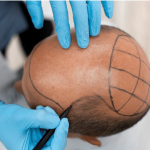Hair Transplantation for Crown Baldness
As people age, the crown of the head often becomes a common area for hair thinning or loss, known as crown baldness or crown hair loss in men. The extent of balding can vary from a slight thinning spot to a larger bald area. While male pattern baldness often begins with a bald spot on the crown, it doesn’t necessarily mean you’ll lose all the hair on top of your head. Another early sign to watch for is a receding hairline.
Crown baldness, a common type of hair loss, typically results in thinning at the top of the scalp. This condition is often caused by androgenetic alopecia, influenced by genetics and the hormone dihydrotestosterone (DHT). Treatment options include hair transplants, oral medications like finasteride, and topical solutions like minoxidil. But does crown baldness mean you’ll inevitably go completely bald? What proactive steps can you take to prevent further hair thinning? And what are the best ways to effectively hide a receding hairline?
Is crown baldness a common type of Hair Loss?
A bald patch on the head is typically one of the early signs of male pattern baldness and is not a natural occurrence. It suggests that hair loss is likely to progress over time, though it doesn’t necessarily mean you’ll lose all the hair on top of your head. Along with or instead of crown thinning, other early signs of male baldness may include a receding hairline.
What are the early signs of balding?
- Finer and thinner hair is the first indication of crown baldness.
- When the shift starts exceptionally mild, it is sometimes difficult to notice this.
- Increased scalp visibility is possible, particularly in low light or after hair washing.
- Finally, individuals frequently observe a shift in the texture of their hair, with each strand being more fragile and having a distinct feel to the touch.
Why do bald patches appear on the crown?
The last indicator is usually a little area of baldness on the head that gradually enlarges.
- DHT has been linked to androgenetic alopecia and a balding crown.
- This is the cause of the emergence of masculine traits, including body hair and a deeper voice.
- DHT, however, can cause issues when it attaches itself to androgen receptors in scalp hair follicles and shrinks them.
- Finer and more prone to shedding will be the new hairs.
- Additionally, DHT can lengthen the telogen phase of the hair development cycle and shorten the anagen phase.
- The time it takes for new hair to regrow will increase longer and longer until it eventually stops.
- Because the hair in these places is more resistant to DHT, the sides and back of the scalp continue to be unaffected.
- Because male pattern baldness is usually inherited from one’s mother or father, you may also have thinned hair if one or both of your parents do.
Other possible reasons
- A bald area on the head can result from conditions other than male pattern hair loss.
- Among the other possible reasons for a balding crown are:
- Prolonged stress on the follicles, typically from over-styling, causes traction alopecia.
- Pulling at one’s hair, frequently without even realizing it, is known as trichotillomania.
- Your immune system unintentionally targets hair follicles, resulting in alopecia areata.
- Telogen effluvium: This hair loss can be brought on by extreme stress.
- Over styling: This might indicate chemical or heat-related damage.
- Medical treatment: Hair loss may result from the adverse effects of several drugs.
- A lack of nutrients Nutrient deficiencies frequently inhibit hair renewal.
- A hormone imbalance can easily throw off the normal hair growth cycle.
- Illness: One of the most frequent reasons for bald patches is illness.
- Trauma: Shock or trauma has the potential to harm hair follicles permanently.
- It is advisable to get oneself examined by a medical practitioner who can precisely identify the underlying reason for your crown hair loss, as there are several possible explanations.
A cycle of hair growth
- Hair grows in cycles rather than continuously. There are three primary phases in the hair growth cycle:
- Phase of anagen: During this stage, hair follicle roots sprout. The matrix cells proliferate, keratinize, and generate hair over the 1,000-day phase, which equates to two to five years. Each year, hair grows around 10 to 15 cm. It is uncommon for a human’s hair to grow longer than one meter. Approximately 85–90% of all hair is in the anagen phase at any given moment.
- Catagen Phase: Usually lasting two to three weeks, this is the transitory regression stage. During this stage, the hair ceases to grow and separates from the root, cutting off the blood supply. The hair follicle becomes around one-sixth of its standard length. Once the bottom portion is destroyed, the dermal papilla separates to begin a resting phase.
- Less than 5% of hair is in the catagen phase at any given moment.
- The phase of Telogen: Cell division stops, hair development slows, and the hair’s attachment to the follicle base is increasingly weaker throughout the several-month-long Telogen phase. Eventually, the old hair sheds and is disposed of due to regular traction from combing, washing the weight of the hair, or a push from newly developing hair. Ten to fifteen percent of all hair follicles are in the telogen phase at any given moment.
Why choose a hair transplant treatment at the DHITM clinic?
DHI technique and its benefits are propriety to DHI Medical Group. Some clinics and doctors try to copy this and claim to use the DHI technique, which is misleading. The following features are only available at DHITM-authorised clinics.
1) We are proud to be ranked #1 on customer satisfaction in a hair transplant industry survey by IMRB. Our customer satisfaction rate is more than 99%. Also, they received the Customer Excellence Award from Quantic and numerous other awards & accreditations from medical bodies worldwide.
2) Our results are not just good; they are fantastic! Click LINK to see our results and LINK to get our customer feedback.
3) We provide hair restoration services for men and women with all stages of hair loss. This includes high growth factor PRP/GFC therapies and Activa Regenera treatment for early-stage alopecia, hair transplants for all stages of alopecia, and the highest-quality natural human hair cosmetic patches for very advanced stages of alopecia. Our hair loss treatment products and nutraceuticals have the highest-grade active ingredients, and you can shop for them here.
4) All procedures are performed from start to finish by DHI doctors trained and certified by the London Hair Restoration Academy. The surgeons are focused only on hair restoration procedures. Every procedure undergoes strict quality control.
5) All procedures are performed per strict standard operating protocols accredited with the UK Care Quality Commission and ISO standards.
6) The world’s safest hair transplant procedure is performed in a sterile environment according to comprehensive safety protocols. All procedures are performed only after proper diagnosis and medical tests.
7) Our patented implanter allows Perfect control over angle, depth, and direction. Only the highest-quality imported instruments are used and discarded after every procedure.
8) One-step implantation to ensure minimal graft handling. The highest graft survival rate is over 90%, compared to 50-90% in other clinics.
9) There are no stitches, pain, scarring, or downtime. You can return to work the next day. It is just a short procedure to regrow your hair naturally and permanently. Daily Mail UK titled DHI the “Lunch Hour Transplant” (click here to read the article).
10) Achieve strong density in a session compared to other low-density techniques such as FUE and FUT.
11) Natural Results Guaranteed – The DHI technique gives you a perfectly natural result; others will only know you had a transplant if you tell them.
12) DHITM is Greece’s world’s largest hair restoration medical group. For more than 50 years, we have focused on research, innovation, and education in hair restoration. We have 75 clinics in 45 countries serving more than 5,00,000 satisfied customers. Top celebrities from the entertainment, sports, business, and politics only trust DHI for their hair restoration.






